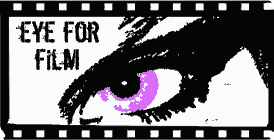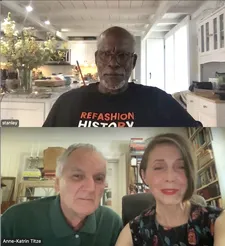From Cape Cod, Massachusetts, Stanley Nelson (co-founder of the multiple award-winning Firelight Media with Marcia Smith), executive producer on Christine Turner’s stellar documentary Sun Ra: Do The Impossible (a highlight in the 24th edition of the Tribeca Festival) was joined by music producer and 99 Records founder Ed Bahlman for a conversation on the creative force known as Sun Ra.
 |
| James Hamilton’s stunning 1981 portrait of Sun Ra in New York City Photo: James Hamilton |
Two memorable SummerStage concerts in Central Park are the ones Sun Ra and His Arkestra opened for Sonic Youth (Kim Gordon, Lee Ranaldo, Thurston Moore, Steve Shelley) on July 4, 1992 and Kim Gordon’s The Collective tour show (with Madi Vogt, Camila Charlesworth, Sarah Register)) 42 years, later on June 13, 2024. Sun Ra, born Herman Blount died on May 30, 1993. And then there is Sun Ra’s extraordinary residency from 1979 into 1981 at the Squat Theatre on West 23rd Street in NYC that Ed attended regularly, which led to a number of revelations between the two of them.
Sun Ra: Do The Impossible starts out beautifully with Sun Ra on piano doing his rendition of Harold Arlen and Yip Harburg’s Over the Rainbow (written for the film The Wizard Of Oz and sung by Judy Garland). From there we enter another dimension where space is the place and travels from planet to planet create freshly minted myths.
We learn about le mot juste for the moon landing, why Sun Ra each morning gave a song to the creator and journey back in time when he played for Black social clubs in the South, his alienation arriving in Chicago in the mid-Forties, and his creation of a bond between musicians that for some lasted a lifetime and beyond. “I’m not part of history, more part of mystery,” said the godfather of Afro-Futurism, resembling the catalyst trickster heroes from ancient tales, with statements as thought-provoking as they were mischievous.
Stanley Nelson: Hello!
Anne-Katrin Titze: Hello! Very nice to meet you, and thank you for talking about Sun Ra before the world première at Tribeca! Are you excited?
SN: Oh, yeah, it should be very exciting!
AKT: I was lucky enough last summer in Central Park to hear the Arkestra, and to actually experience the magic a little bit, because when they started playing Stranger in Paradise, somehow the entire park transformed. It was like Shakespeare's Midsummer Night's Dream, everybody's mood changed, it was great. What was your first encounter with Sun Ra?
SN: I think just knowing and hearing his music. I saw the Arkestra for the first time, maybe three or four years ago, but I had been familiar with the music for years before that.
AKT: And now this documentary will definitely reach a wider audience, and it's good timing for his voice to be heard.
SN: Yeah, I think it's very important. One of the things that we say in the film is that Sun Ra was trying to open up people's minds that there is a different way of being, that there's a whole other way of being. And he represented a different way. I think that's really a message that's important now, when things have seemed to have gone so, especially in this country, so haywire.
AKT: There's this fabulous phrase in the film: If you are not a myth, whose reality are you? And if you are not a reality, whose myth are you? It's very profound and sums up what he was about.
SN: I think that's exactly right. If you're not part of this myth, then we can create our own myths. And that's what Sun Ra was in essence trying to do, creating our own myths. That's really important, I think, especially in this time, where the reality is just as insane as some myths.
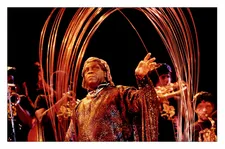 |
| Sun Ra under copper arches with Arkestra on stage Photo: Leni Sinclair |
AKT: He asks about the Black mythological world as well, and the lost myths, trying to find them. At the same time he is called later on in the film a trickster himself, which made me think of Anansi and all those fabulous trickster heroes.
SN: Yeah, I mean Sun Ra was a trickster. The idea that you always struggle with in the film, the audience is, is he for real? Is he serious? But I think he is very serious about the fact that there's another way of being. Whether it's extreme as Sun Ra and his Arkestra, or is the Arkestra just a tool for opening people's minds up to a different reality? I think that's always the struggle that we hope the audience will see and think about.
AKT: He's thought provoking. And audiences have to do some work, which is what we should do for a good film. Somebody says it was not a stage performance at all. This was him, this was his day-to-day existence. I loved that every morning he gave a new song to the Creator. How lovely is that! I don't think I've ever heard it phrased like that before.
SN: Yeah, I think there's something really magical and beautiful about that idea that we're always asking the Creator for something. That's what humans do constantly, but that he felt that it was important to give back to the Creator. And that his music was something that he could give to the Creator. I think that's really important. I also think that it's really interesting, as you said, that this was Sun Ra. I mean, we have other performers who put on costumes and go on stage, and perform, and then they come off stage, take off the costume where they become their real selves. This was Sun Ra 24/7, that being.
 |
| Sun Ra in orange light and haze plays piano and glares at camera Photo: Hans Kumpf |
AKT: And as much as he was giving to the Creator, at the same time the film doesn't shy away from talking about his stinginess with paying people, paying his musicians.
SN: I think that's one of the fascinating things about Sun Ra and his Arkestra, the way that they were structured, that for a good part they lived in the house in Philadelphia, and they were almost a commune, and played music all the time And that’s the only way that they could kind of survive, at least in my opinion was for Sun Ra to keep close reins on the finances, and I love where former members or present members of the Arkestra talked about how he could be very stingy, he’d dole out money for expenses, but that was about it. He kept this group of musicians together for a long period of time and I think that's really important.
AKT: Another part that I liked was about the moon landing, the poem he provided to the magazine, when other people were just making little jokes. It's his realm, it's outer space. There were some lovely archival bits as well!
SN: As filmmakers, we tried, Christine Turner, the director, and we knew it was really important. The archival pieces - we really worked hard for over a year to find any kind of clips, any kind of pictures, poems, statements, magazine articles that would help shed light on Sun Ra. It was a deep dive and different from anything that's ever been done about Sun Ra, because we spent a lot of time and energy, finding all the different archival pieces that we use in the film.
 |
| Kim Gordon on June 13, 2024 - Sonic Youth on July 4, 1992 with Sun Ra and His Arkestra Photo: Ed Bahlman, Thurston Moore |
AKT: From meeting with students to traveling to Egypt, all of that gives you a broader picture. I have someone here who would like to say hello to you, Ed Bahlman, producer and founder of 99 Records, who met Sun Ra many times!
SN: Hi! How are you?
Ed Bahlman: Great to meet you! Terrific film!
SN: Oh, thank you, it's the world première on Tuesday, so you're a very select two people who've seen the film. It means a whole lot for you guys to say that the film works and is good, because you're the first two people that I've seen that have seen the film and haven't worked on it.
EB: I met Sun Ra when he did his residency at the Squat Theatre in ’79 to ’81. I looked it up. The same years I had a shop that only sold independent music on MacDougal Street. It was called 99. I went many times to the Squat Theatre to see him perform and he would recognise me as a regular, and that smile of his, the joy I felt just seeing him again!
SN: That's a great story. I think that whether he was from Saturn or outer space, you know he was a very special human being.
EB: He radiated that simply by being there. Even in other locations, like on the street, he would remember that we had interacted and he was curious about what I was doing with 99 and my record label. Because I discovered ESG. Do you know them?
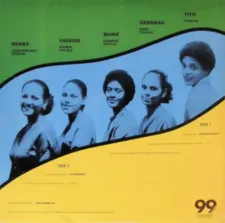 |
| ESG 12” EP mastered by Ed Bahlman, Martin Hannett (studio tracks producer), Ed Bahlman (sound recording and producer live tracks) on 99 Records |
SN: No, I'm sorry I don't.
EB: Four Black sisters from the South Bronx. They have the song UFO, which is the most sampled recording in hip-hop history.
SN: Really?
EB: Yeah, everybody. Even Miles Davis.
SN: Really! I'll take a listen! Is it online somewhere?
EB: Yeah, you can see it, I'll show you. They just played on the Lincoln Center American Songbook tribute to Fanny. This is their album [Ed holds it up].
SN: ESG come away with ESG. I will look for it. I'm going to write it down so I don't forget.
EB: And I completely understand about trying to keep an orchestra together, because I also worked with Glenn Branca, the composer and he had to use six, seven, eight guitar players when he performed live. Some of them went on to create Sonic Youth. So it was impossible for him to keep the musicians together. That's the unusualness of Sun Ra, as you said, it was a family. It was people sticking together.
SN: Yeah, I think that there are very few people who are able with their charisma and their music to hold people together. Duke Ellington is always cited, and Sun Ra kept people together for long, long periods of time. I think that's a testament to what he was doing.
EB: Did you ever work on any shows that Ron Delsener presented?
SN: No, I know the name, but I never did.
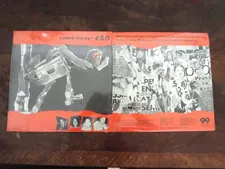 |
| come away with ESG (99-003LP), produced and mastered by Ed Bahlman - 99 Records |
AKT: Someone mentions Sun Ra’s fertility, that he made things, just not people.
SN: I love that line, I think that's really kind of funny.
AKT: You're wearing a fabulous T-shirt: Refashion History. What is that about?
SN: It's from this organisation called The History Makers, who have done, I think, over a thousand interviews of different African Americans, from all different walks of life, especially people who they think have made an impact. It's almost like an archive that they have done all these interviews to preserve people and what they're thinking.
EB: Another credit to you and your team is that there were no reenactments and no use of animation. That's so much appreciated, because that seems to be the overwhelming trend nowadays to fill the gaps. They don't do the hard work.
SN: Yeah, I mean, I love animation but it's very, very tricky to not seem kind of hokey and to go into a cartoon world.
EB: And it can't be used to fill a gap because it becomes obvious that that's what's happening, especially if you care about the person or the subject. Who is coming for the première?
SN: Right! We're really excited to première the film. It's a big step, and I can't wait to see it with an audience. Christine Turner, the director, and I believe both editors are coming. There are two different editors of the film. Everybody that's involved. I don't think that any of the musicians are coming to be on the panel, the première is more for the people who created the film.
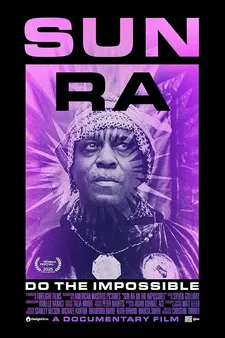 |
| Sun Ra: Do The Impossible poster |
EB: It's a fascinating documentary. We went to SummerStage in Central Park because Kim Gordon was the headlining act, formerly of Sonic Youth, and she's a dear friend of mine from the late Seventies through this time. I think Sonic Youth played with Sun Ra in the Nineties sometime and I just wrote her to try to get the year in the place where they played together. As we walked in, because we had a ticket through the press, I told Anne-Katrin, “space is the place” and then you have the clip [of the song] in the film!
SN: Yeah, I think that really works for the film.
EB: So far ahead of its time. Yeah, all these theories that are coming in the last five, six years are definitely influenced by what he was doing there.
SN: It's an interesting film.
AKT: When Sun Ra speaks of the mythological world, I was reminded of the fabulous book that Henry Louis Gates Jr. and his Harvard colleague Maria Tatar edited together “The Annotated African American Folktales.” It came out a few years ago.
SN: I'll try to get it, I think that sounds really interesting. Thank you, this is great. Because again, you're the first people that I've talked to who've actually seen the film. And so it's a great deal that you enjoyed it. I want to also just say that about two months ago we finished another film about music called, We Want the Funk. You should take a look at that, it’s a totally different film. It's a film about funk music, you can get it on pbs.org. Or you could just type in “We Want the Funk” on Youtube. And it's a really different, joyous, joyous, joyous film.
EB: In 2021 we did a conversation with Melissa Haizlip, the niece of Ellis Haizlip, who created the show Soul! on PBS.
SN: Yeah, we worked with her, Firelight Films and Firelight Media worked with Melissa on her film.
EB: She knew ESG, so we talked about them.
AKT: Thank you and all the best at Tribeca!
SN: Thank you all so much! If you want a film of pure joy, please watch We Want the Funk, it's a hilarious, insane film, and it's really fun.
EB: I’ll look for it!
SN: Okay, we'll talk to you soon. Bye, bye!
